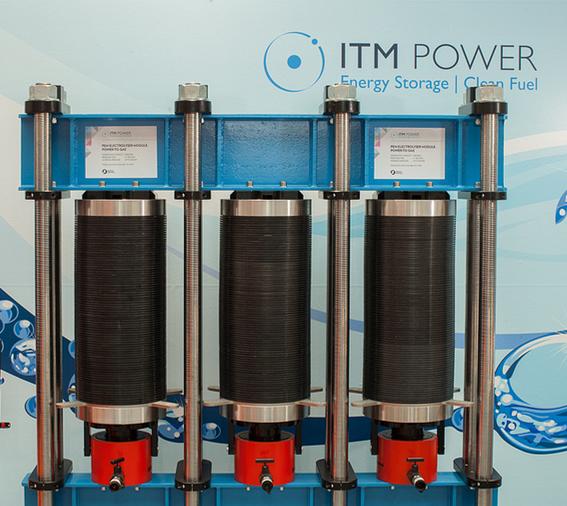|
Power To Gas
Power-to-gas (often abbreviated P2G) is a technology that uses electric power to produce a gaseous fuel. Most P2G systems use electrolysis to produce hydrogen. The hydrogen can be used directly, or further steps (known as two-stage P2G systems) may convert the hydrogen into syngas, methane, or LPG. Single-stage P2G systems to produce methane also exist, such as reversible solid oxide cell (rSOC) technology. Produced gas, just like natural gas or industrially produced hydrogen or methane, is a commodity and may be used as such through existing infrastructure (pipelines and gas storage facilities), including back to power at a loss. However, provided the power comes from renewable energy, it can be touted as a carbon-neutral fuel, renewable, and a way to store variable renewable energy. Power-to-hydrogen All current P2G systems start by using electricity to split water into hydrogen and oxygen by means of electrolysis. In a "power-to-hydrogen" system, the resulting hydr ... [...More Info...] [...Related Items...] OR: [Wikipedia] [Google] [Baidu] |
Electric
Electricity is the set of physical phenomena associated with the presence and motion of matter possessing an electric charge. Electricity is related to magnetism, both being part of the phenomenon of electromagnetism, as described by Maxwell's equations. Common phenomena are related to electricity, including lightning, static electricity, electric heating, electric discharges and many others. The presence of either a positive or negative electric charge produces an electric field. The motion of electric charges is an electric current and produces a magnetic field. In most applications, Coulomb's law determines the force acting on an electric charge. Electric potential is the Work (physics), work done to move an electric charge from one point to another within an electric field, typically measured in volts. Electricity plays a central role in many modern technologies, serving in electric power where electric current is used to energise equipment, and in electronics dealing w ... [...More Info...] [...Related Items...] OR: [Wikipedia] [Google] [Baidu] |
Variable Renewable Energy
Variable renewable energy (VRE) or intermittent renewable energy sources (IRES) are renewable energy sources that are not dispatchable due to their fluctuating nature, such as wind power and solar power, as opposed to controllable renewable energy sources, such as dammed hydroelectricity or bioenergy, or relatively constant sources, such as geothermal power. The use of small amounts of intermittent power has little effect on grid operations. Using larger amounts of intermittent power may require upgrades or even a redesign of the grid infrastructure. Options to absorb large shares of variable energy into the grid include using storage, improved interconnection between different variable sources to smooth out supply, using dispatchable energy sources such as hydroelectricity and having overcapacity, so that sufficient energy is produced even when weather is less favourable. More connections between the energy sector and the building, transport and industrial sectors may also ... [...More Info...] [...Related Items...] OR: [Wikipedia] [Google] [Baidu] |
Solvay (company)
Solvay is a Belgian-French multinational chemical company established in 1863, with its headquarters located in Neder-Over-Heembeek, Brussels, Belgium. Since the end of 2023, following its demerger with the creation of the new Syensqo entity, Solvay has specialized in essential chemistry and employs over 9,000 people in 40 countries. In 2023, Solvay reached €4,880 million in revenues and €1,246 million of underlying EBITDA. Solvay is listed on Euronext Brussels. History The evolution of Solvay Founded in 1863, by Ernest Solvay and his brother Alfred Solvay to produce sodium carbonate by the Solvay process, the company has diversified into two main sectors of activity: chemicals and plastics. Before Solvay was the largest multinational company in the world. It was formerly also active in pharmaceutical industry, pharmaceuticals, but agreed to sell that entire division to Abbott Laboratories, Abbott Labs for €4.5 billion in September 2009, a deal was completed in Feb ... [...More Info...] [...Related Items...] OR: [Wikipedia] [Google] [Baidu] |
Power To Gas HGas
Power may refer to: Common meanings * Power (physics), meaning "rate of doing work" ** Engine power, the power put out by an engine ** Electric power, a type of energy * Power (social and political), the ability to influence people or events Mathematics, science and technology Computing * IBM POWER (software), an IBM operating system enhancement package * IBM POWER architecture, a RISC instruction set architecture * Power ISA, a RISC instruction set architecture derived from PowerPC * IBM Power microprocessors, made by IBM, which implement those RISC architectures * Power.org, a predecessor to the OpenPOWER Foundation Mathematics * Exponentiation, "''x'' to the power of ''y''" * Power function * Power of a point * Statistical power Physics * Magnification, the factor by which an optical system enlarges an image * Optical power, the degree to which a lens converges or diverges light Social sciences and politics * Economic power, encompassing several concepts that economists use ... [...More Info...] [...Related Items...] OR: [Wikipedia] [Google] [Baidu] |
Hessen
Hesse or Hessen ( ), officially the State of Hesse (), is a state in Germany. Its capital city is Wiesbaden, and the largest urban area is Frankfurt, which is also the country's principal financial centre. Two other major historic cities are Darmstadt and Kassel. With an area of 21,114.73 square kilometers and a population of over six million, it ranks seventh and fifth, respectively, among the sixteen German states. Frankfurt Rhine-Main, Germany's second-largest metropolitan area (after Rhine-Ruhr), is mainly located in Hesse. As a cultural region, Hesse also includes the area known as Rhenish Hesse (Rheinhessen) in the neighboring state of Rhineland-Palatinate. Etymology The German name , like the names of other German regions ( " Swabia", " Franconia", "Bavaria", "Saxony"), derives from the dative plural form of the name of the inhabitants or eponymous tribe, the Hessians (, singular ). The geographical name represents a short equivalent of the older compound name ( ... [...More Info...] [...Related Items...] OR: [Wikipedia] [Google] [Baidu] |
Frankfurt
Frankfurt am Main () is the most populous city in the States of Germany, German state of Hesse. Its 773,068 inhabitants as of 2022 make it the List of cities in Germany by population, fifth-most populous city in Germany. Located in the foreland of the Taunus on its namesake Main (river), Main, it forms a continuous conurbation with Offenbach am Main; Frankfurt Rhein-Main Regional Authority, its urban area has a population of over 2.7 million. The city is the heart of the larger Rhine-Main metropolitan region, which has a population of more than 5.8 million and is Germany's Metropolitan regions in Germany, second-largest metropolitan region after the Rhine-Ruhr metropolitan region, Rhine-Ruhr region and the List of EU metropolitan regions by GDP#2021 ranking of top four German metropolitan regions, fourth largest metropolitan region by GDP in the European Union (EU). Frankfurt is one of the ''de facto'' four main capitals of the European Union (alongside Brussels, Luxembourg Cit ... [...More Info...] [...Related Items...] OR: [Wikipedia] [Google] [Baidu] |
Mainova
Mainova AG ( FWBMNV6 is one of the largest regional energy suppliers in Germany and supplies about one million people in Hessen Hesse or Hessen ( ), officially the State of Hesse (), is a state in Germany. Its capital city is Wiesbaden, and the largest urban area is Frankfurt, which is also the country's principal financial centre. Two other major historic cities are Da ... and neighboring provinces with electricity, gas, heat and water. It is based in Frankfurt am Main. History Mainova AG was formed in 1998 through the merger of Stadtwerke Frankfurt am Main GmbH and Maingas AG. Corporate structure The energy and water utility has approximately 2,900 employees and posted 2009 sales of €1.66 billion. The largest shareholder of Mainova are the government of Frankfurt am Main with a 75.2% ownership stake of shares and Thüga AG with 24.4% of the shares. The remaining shares (0.4%) are freely floated. The board members are Dr. Constantin Alsheimer (CEO), Norbert Breidenbach, D ... [...More Info...] [...Related Items...] OR: [Wikipedia] [Google] [Baidu] |
AEG (German Company)
; AEG) was a German producer of electrical equipment. It was established in 1883 by Emil Rathenau as the ''Deutsche Edison-Gesellschaft für angewandte Elektricität'' in Berlin. The company's initial focus was driven by electrical lighting, as in 1881, Rathenau had acquired the rights to the electric light bulb at the International Exposition of Electricity in Paris. Using small power stations, his company introduced electrical lighting to cafés, restaurants, and theaters, despite the high costs and limitations. By the end of the 19th century, AEG had constructed 248 power stations, providing a total of 210,000 hp of electricity for lighting, tramways, and household devices. During the World War II, Second World War, AEG worked with the Nazi Party and benefited from forced labour from concentration camps. After the war, its headquarters moved to Frankfurt am Main. In 1967, AEG joined with its subsidiary Telefunken, Telefunken AG, creating ''Allgemeine Elektricitäts-Ge ... [...More Info...] [...Related Items...] OR: [Wikipedia] [Google] [Baidu] |
Electrolyser
In chemistry and manufacturing, electrolysis is a technique that uses direct electric current (DC) to drive an otherwise non-spontaneous chemical reaction. Electrolysis is commercially important as a stage in the separation of elements from naturally occurring sources such as ores using an electrolytic cell. The voltage that is needed for electrolysis to occur is called the decomposition potential. The word "lysis" means to separate or break, so in terms, electrolysis would mean "breakdown via electricity." Etymology The word "electrolysis" was introduced by Michael Faraday in 1834, using the Greek words "amber", which since the 17th century was associated with electrical phenomena, and ' meaning "dissolution". Nevertheless, electrolysis, as a tool to study chemical reactions and obtain pure elements, precedes the coinage of the term and formal description by Faraday. History In the early nineteenth century, William Nicholson and Anthony Carlisle sought to further Volt ... [...More Info...] [...Related Items...] OR: [Wikipedia] [Google] [Baidu] |
Proton Exchange Membrane
A proton-exchange membrane, or polymer-electrolyte membrane (PEM), is a semipermeable membrane generally made from ionomers and designed to conduct protons while acting as an electronic insulator and reactant barrier, e.g. to oxygen and hydrogen gas. This is their essential function when incorporated into a membrane electrode assembly (MEA) of a proton-exchange membrane fuel cell or of a proton-exchange membrane electrolyser: separation of reactants and transport of protons while blocking a direct electronic pathway through the membrane. PEMs can be made from either pure polymer membranes or from composite membranes, where other materials are embedded in a polymer matrix. One of the most common and commercially available PEM materials is the fluoropolymer (PFSA) Nafion, a DuPont product. While Nafion is an ionomer with a perfluorinated backbone like Teflon, there are many other structural motifs used to make ionomers for proton-exchange membranes. Many use polyaromatic polymer ... [...More Info...] [...Related Items...] OR: [Wikipedia] [Google] [Baidu] |
High-pressure Electrolysis
High-pressure electrolysis (HPE) is the electrolysis of water by decomposition of water (H2O) into oxygen (O2) and hydrogen gas (H2) due to the passing of an electric current through the water. The difference with a standard proton exchange membrane (PEM) electrolyzer is the compressed hydrogen output around at 70 °C. By pressurising the hydrogen in the electrolyser the need for an external hydrogen compressor is eliminated, the average energy consumption for internal differential pressure compression is around 3%. Approaches As the required compression power for water is less than that for hydrogen-gas the water is pumped up to a high-pressure, in the other approach differential pressure is used. There is also an importance for the electrolyser stacks to be able to accept a fluctuating electrical input, such as that found with renewable energy. This then enables the ability to help with grid balancing and energy storage. Ultrahigh-pressure electrolysis Ultrahigh-press ... [...More Info...] [...Related Items...] OR: [Wikipedia] [Google] [Baidu] |







